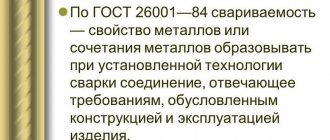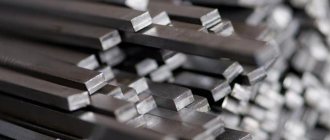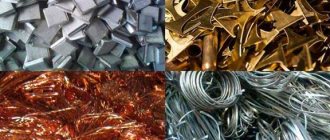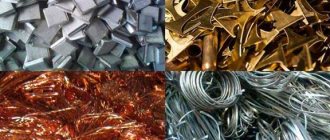What is the weldability of materials?
Physical weldability of metals is the property of materials to form a monolithic joint, i.e. their ability to mutually crystallize with the formation of solid solutions, chemical compounds and fine mixtures of phase components (eutectics). These processes occur at the boundary of the base and deposited metal and characterize weldability from the point of view of the possibility of forming a metallic bond and the fundamental possibility of obtaining permanent welded joints.
Technological weldability of metals is a technological characteristic of a metal that determines its response to the effects of welding and the ability to form a permanent welded joint with specified performance properties at the lowest cost. That is, it reflects the technological response of the material to the thermal, force and metallurgical effects of welding.
The weldability of a metal depends on its chemical and physical properties, the type of crystal lattice, the degree of alloying, the presence of impurities and a number of other factors.
The weldability of steels is assessed according to the following indicators:
- the tendency of the weld metal to form hot and cold cracks;
- tendency to change the structure in the heat-affected zone and to form hardening structures;
- physical and mechanical qualities of the welded joint (strength, ductility, impact strength, etc.);
- compliance of the special properties of the welded joint with the requirements of the technical specifications for the design (corrosion resistance, heat resistance, heat resistance, resistance to brittle fracture at low temperatures, etc.).
Simply put, the difference between materials with good and poor weldability is that more complex welding technology is required to join the latter.
Carbon has the greatest influence on the weldability of steels. Weldability deteriorates with increasing carbon content, as well as a number of other elements. For the manufacture of welded structures, structural low-carbon, low-alloy and alloy steels are mainly used. The main difficulties in welding alloy steels are their tendency to form hardening structures, hot and cold cracks, as well as deterioration of mechanical properties - primarily a decrease in ductility in the welded joint zone. The higher the carbon content in the steel, the more pronounced these disadvantages are, and the more difficult it is to ensure the required properties of the joint.
Approximate quantitative indicators of the weldability of steels are the equivalent carbon content, determined by the formula:
where the content of carbon and alloying elements is expressed as a percentage. Depending on the equivalent carbon content, structural steels are divided into 4 groups, which are characterized by satisfactory, limited or poor weldability.
Group 1: good weldability, SEQ ≤ 0.25%, weldability without the use of special techniques (st.2; st.3; 10G2; 09G2; 10G2S).
Group 2: satisfactory weldability, Sekv -0.25 - 0.35 - strict adherence to welding conditions, the use of special filler materials, in some cases - preliminary and concomitant heating to 100 - 1500 C, heat treatment are required (steels 15GS, 15 KhM, 10HSND , 14HGS, 15HSND, 15HGSA, 18G29).
Group 3: limited weldability, SEq - 0.35 - 0.45, requires heating to 100 - 2000 C and tempering after welding. Before welding, the parts are subjected to heat treatment (steels 12N1MF, 20KhMFL, 15Kh1M1FL, 30KhGS, 35G2, 30KhM, 10GN2MFA, 15Kh2NMFA).
Group 4: poor weldability, SEq > 0.45. High tendency to cold cracks in the weld and heat-affected zone. When welding, preheating to 250 - 4000C and subsequent heat treatment are required (steels 45Kh, 45G, 40G2, 40KhS, 40KhMFA, 35KhGSA, 30KhI3A, 40KhN2MA, 36Kh2R2MFA).
There is still no generally accepted method for determining the weldability of metals. In most cases, the techniques are based on welding special samples in which harsh conditions for the weld are created. However, there are also calculation methods that relate the maximum hardness and type of structure of the heat-affected zone of a given steel to the need to heat the part before welding, the design of the joint and the thickness of the metal. Calculation methods make it possible to theoretically calculate welding modes that ensure obtaining a given hardness and structure.
Heat-resistant and high-strength steels
Welding work with heat-resistant iron-carbon alloys 12МХ, 12Х1М1Ф, 25Х2М1Ф, 15Х5ВФ must be carried out with preheating to temperatures of 300-450˚С, with final hardening and high tempering.
- Electric arc welding in a cascade method for forming a multilayer seam, using calcined coated electrodes UONII 13/45MH, TML-3, TsL-30-63, TsL-39.
- Gas welding with acetylene supply 100 dm3/mm using filler materials Sv-08KhMFA, Sv-18KhMA. The pipe connection is carried out with previous gas heating of the entire joint.
When welding medium-alloyed high-strength materials 14Х2ГМ, 14Х2ГМРБ, it is important to follow the same rules as for heat-resistant steels, taking into account some nuances:
- Carefully clean the edges and use tacks.
- High-temperature calcination of the electrode (up to 450˚С).
- Preheating to 150˚C for parts thicker than 2 cm.
- Slow cooling of the seam.
Aluminum alloys
Duralumin, silumin, avmel and other aluminum-based alloys vary greatly in weldability. Aluminum is welded with an electric arc using consumable and non-consumable electrodes, using equipment that generates direct current. The contacts are connected in reverse polarity. It is recommended to preheat the workpieces:
- thickness up to 8 mm – up to 200°C;
- over 8 mm – up to 400°C.
They weld aluminum at currents up to 200 A with sheet thickness up to 4 mm without preliminary cutting of edges. For workpieces over 4 mm, the edges are ground at an angle and cooked at currents 35-40 times greater than the thickness of the workpiece (up to 160 A). A high-quality gas environment is used so that the cloud does not move from the working area during the formation and hardening of the seam. The distance between the tacks is made taking into account the thickness of the workpiece:
| Workpiece thickness, mm | Interval between tacks, mm |
| 1,5 | up to 30 |
| 3 | up to 50 |
| 5 | 5 — 80 |
| 10 | 10 — 120 |
| 20 | 25 — 200 |
The refractory or carbon electrode that ignites the electric arc is held at right angles to the additive to prevent lack of penetration of the weld root.
Classification of steels according to physical, chemical and technological characteristics
According to the physical properties in the classification (EN 10027 standard), steel groups are distinguished:
– with special physical properties (electrical conductivity, coefficient of linear expansion, etc.); – with special magnetic properties (magnetic permeability).
Classification of steels according to mechanical properties:
– strength (for example, Rm 500 N/mm2, 500 ≤ Rm 700 N/mm2, Rm ≥ 700 N/mm2); – yield strength (for example, Re = 235, 275...or Re 360, Re 380 N/mm2); – relative elongation (for example, δ≥15, 25 or 35%); – impact strength (for example, impact work of 27, 40 or 60 J at +20, 0, -20, -40, -60°C); – other characteristics.
According to chemical characteristics, steels are classified into:
– resistant to chemical corrosion (at normal temperatures – stainless steels; at high temperatures – heat-resistant steels); – resistant to electrochemical corrosion (steels for operation at normal, elevated or high temperatures, resistant to MCC).
Technological classification characteristics:
– method of producing steel (boiling, semi-calm, calm steel); – thermal and thermomechanical treatment (hardenability, annealing, normalization, hardening and tempering, cold hardening, cold rolling, hot forming, etc.); – the ability of steels to be processed by pressure (for example, stamping), cutting, casting, etc.; – weldability (according to the Sekv criterion, the content of the ferrite phase in austenitic steels, etc.).
Classification of steels by purpose:
When classifying steels by purpose, one group may contain steels of different alloying systems and different quality classes.
Non-alloy steels are classified according to purpose into the following groups:
– structural general purpose; – general purpose construction; – for pressure vessels; – pipe; – mechanical engineering; – shipbuilding; – automatic (with a high content of P and S); – reinforcement; – rail; – cold- and hot-rolled for cold working; – instrumental; – electrical engineering.
Alloy steels are classified according to their intended purpose into:
– construction; – mechanical engineering; – shipbuilding; – for pressure vessels; – for pipelines; – for nuclear reactors; – for cryogenic equipment; – for bearings; – stainless steels; – heat-resistant steels; – heat-resistant; – heat-resistant; – instrumental; – high-speed; – with special physical properties.
Nickel alloys
Nickel-based non-ferrous alloys are characterized by high toughness and ductility. Nickel parts melt at 700–1000°C, the process is accompanied by saturation of the alloys with gases, the weld becomes porous and fragile. Although nickel is resistant to corrosion. When argon arc welding, electrodes with niobium, silicon, and aluminum are selected. The presence of manganese and magnesium in the melt is also desirable. The weldability of the metal increases and a strong connection is formed.
To work with nickel alloys, welding machines that produce a constant operating current are needed. Welding of nickel non-ferrous workpieces is carried out using a current of reverse polarity so that the shielding gas is ionized and the electric arc becomes more stable. With reverse polarity, the workpiece heats up less than the electrode. This is especially true for workpieces of small thickness. By adjusting the current potential, the temperature of the workpiece can be reduced.
Possible difficulties when welding
During the work, the contractor may encounter the following problems:
- Arc deflection (magnetic blast). The field can be created by the workpiece or nearby cables. To prevent this phenomenon, the parts are first demagnetized and the work area is fenced off with screens. With direct polarity, you should cook in the direction of the mass clamp, with reverse polarity, away from it.
- The appearance of defects such as lack of penetration or through-burning of the workpiece. Explained by setting the wrong current value. In the instructions for consumables, the recommended amperage is indicated as a range, for example 80-140 A. The exact value is selected experimentally. Lack of penetration occurs when the indicator is underestimated, burn-through occurs when the indicator is too high.
- Flowing out of the melt from the weld pool when making vertical and ceiling seams. To avoid this phenomenon, it is necessary to reduce the welding current and use special consumables that produce viscous slag.
- The appearance of defects in the form of crystallization hot cracks and brittle hardening inclusions. This is explained by the increased concentration of carbon.
The welding process depends mainly on the carbon content of the steel.
The amount of carbon in the weld is affected by:
- Node design.
- Joint shape.
- Preheating of workpieces.
- Metal composition.
It follows that the following measures will help prevent cracking:
- Reduction of tensile stresses in the seam.
- Formation of a joint of the correct shape with a homogeneous chemical composition.
- Reducing the concentration of harmful elements.
Titanium processing
Titanium in the molten state reacts violently with three components of air: oxygen, hydrogen, nitrogen. It is necessary to reduce their content in the protective atmosphere to a minimum. The gas must be of high quality if you need a reliable seam. It must cool in a protective atmosphere to prevent cracks from forming. For welding titanium on an industrial scale, sealed chambers are used. When manual welding, it is necessary to shield the working area so that the cloud of inert gas does not move from the seam; argon or helium, mixtures must be of the first or highest grade. Due to its high density, the shielding gas will displace air. Welding equipment that generates direct current is used. Welding of non-ferrous metal is carried out with a current of straight polarity. The main thermal load is concentrated on the surface of the workpiece, the root of the weld deepens, the arc is maintained stably, and the metal spatters less.
Works with magnesium
For magnesium parts, the entire edge is boiled. To work with workpieces thicker than 10 mm, you need powerful welding equipment operating from a three-phase network with a power of 380 V, generating alternating high-frequency current. During periods of reverse polarity, the arc breaks through the oxide film and it melts. When working, it is recommended to use pads with low thermal conductivity.
Welding of magnesium and non-ferrous metals based on it is carried out under the atmospheric protection of helium or argon; it protects the melt from saturation with nitrogen, the weld does not bubble, and scale does not form on it. The supply of gas to the working area begins before the arc is ignited, and is stopped 20 seconds after extinction, when the upper part of the seam has set.
Features of welding non-ferrous metals
During the phase transition process, light components evaporate and burn out, which has a detrimental effect on the condition of the seam. It's cracking. Refractory oxides are another problem. Sometimes it is necessary to increase the operating current to break through the oxide. When welding non-ferrous metals and alloys, the melt often becomes too fluid; it is necessary to isolate the melt pool. For some alloys, it is necessary to limit not only contact with oxygen, but also other components of the air. Nitrogen is not suitable as a protective atmosphere for some alloys.









